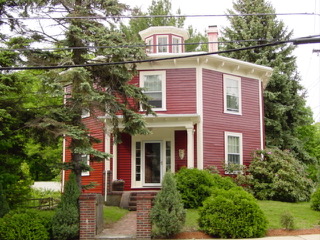
The William Bryant Octagon House is an historic octagon house located at 2 Spring Street in Stoneham, Massachusetts. Built in 1850, it is the best-preserved of three such houses built in the town in the 1850s. It was listed on the National Register of Historic Places in 1984.

Adams is a former train station at 10 Pleasant Street in Adams, Massachusetts. Built in 1899, it served as the town's principal rail station on the North Adams Branch of the Boston and Albany Railroad until the mid-20th century. The surviving buildings were listed on the National Register of Historic Places in 1982 as the Pittsfield & North Adams Passenger Station and Baggage & Express House. The former station is currently the home of a sports bar and restaurant.

The Nathan Frye House is a historic house at 166 N. Main Street in Andover, Massachusetts. The large mansion was built in 1851-52 for Nathan Frye, who had recently (1849) become president of the Marland Mill Company, one of Andover's major textile firms. It features grand Italianate details, including bracketed eaves, corner quoins, and pedimented gables. The building and its associated carriage house have been extensively altered for commercial purposes in the late 20th century, but much of the architectural interest has been retained.

The Joseph Temple House is a historic house at 42 Chute Street in Reading, Massachusetts. The Second Empire wood frame house was built in 1872 by Joseph Temple, owner of locally prominent necktie manufacturer. The house was listed on the National Register of Historic Places in 1984.
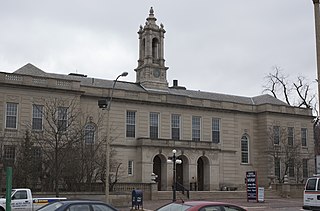
The Arlington Center Historic District includes the civic and commercial heart of Arlington, Massachusetts. It runs along the town's main commercial district, Massachusetts Avenue, from Jason Street to Franklin Street, and includes adjacent 19th- and early 20th-century residential areas roughly bounded by Jason Street, Pleasant Street, and Gray Street. The district was listed on the National Register of Historic Places in 1974.

Old North Cemetery is a historic cemetery on North State Street in Concord, New Hampshire. Established in 1730, it is the city's oldest cemetery. Franklin Pierce, fourteenth president of the United States, is buried in the cemetery, as are his wife Jane and two of his three sons. It was listed on the National Register of Historic Places on November 9, 2008. The cemetery continues to accept new burials.
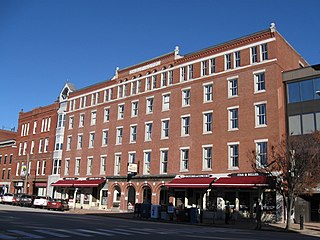
The Eagle Hotel is a historic hotel building at 110 North Main Street in Concord, New Hampshire. Built in 1851, it has been a prominent local landmark since then, and a meeting place for state politicians, given its location across the street from the New Hampshire State House. The building was listed on the National Register of Historic Places in 1978.

The Potter Place Railroad Station is a historic railroad station on Depot Street in Andover, New Hampshire. Built in 1874, it is one of the best-preserved surviving 19th-century railroad stations in Merrimack County. It now houses the museum of the Andover Historical Society. It was listed on the National Register of Historic Places in 1989.

The Laconia Passenger Station is a historic railroad station at 9-23 Veterans Square in downtown Laconia, New Hampshire. It was built in 1892 for the Boston and Maine (B&M) Railroad and is a prominent regional example of Richardsonian Romanesque architecture. It was added to the National Register of Historic Places in 1982. The building now houses a variety of commercial businesses.

The Chamberlin House is a historic house at 44 Pleasant Street in Concord, New Hampshire. Built in 1886, it is a prominent local example of Queen Anne architecture built from mail-order plans, and now serves as the clubhouse of the Concord Women's Club. It was listed on the National Register of Historic Places in 1982.

The William Hayden House is a private residence located at 108 West Pottawatamie Street in the city of Tecumseh in northeast Lenawee County, Michigan. It was designated as a Michigan Historic Site and added to the National Register of Historic Places on August 13, 1986.

The Henry J. Crippen House is a historic two-family house at 189-191 North Main Street in Concord, New Hampshire. Built about 1879, it is one of a dwindling number of little-altered surviving Second Empire residences on the city's Main Street. Now converted to professional offices, it was listed on the National Register of Historic Places in 1983.

The Downtown Concord Historic District encompasses most of the commercial heart of downtown Concord, New Hampshire, United States. Incorporated in 1734, Concord became the state capital in 1808 and the seat of Merrimack County in 1823. Economic growth followed, due in part to these government institutions and also to the rise of industry along the Merrimack River, which flows through the city east of the downtown area, and the arrival in the 1840s of the railroad. The New Hampshire State House was built in 1819 south of the traditional center of the city, and the commercial heart of the city began to take shape along the First New Hampshire Turnpike south of the State House. The district was listed on the National Register of Historic Places in 2000.

Leavitt Farm is a historic farmstead at 103 Old Loudon Road in eastern Concord, New Hampshire. It consists of three 19th century farm buildings, including the c. 1847 Greek Revival farmhouse, a large c. 1888 shop and barn, and a 19th-century privy which has been converted into a well pumphouse. These buildings were built by Jonathan Leavitt, a farmer and blacksmith, and were later owned by his son Almah, a sign painter. In the 1980s the property was used by the Concord Coach Society as a headquarters and museum facility. The shop building in particular is notable for its adaptive reuse, and for its second floor ballroom space, an unusual location for that type of social space. The property was listed on the National Register of Historic Places in 1982.
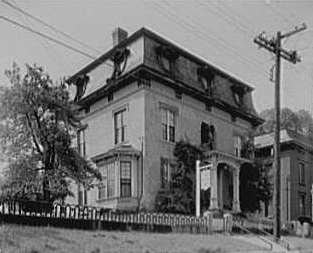
The Franklin Pierce House was an historic house at 52 South Main Street in Concord, New Hampshire, United States. Built in 1852, it was a significant local example of Second Empire architecture, and was one of two surviving Concord homes of President Franklin Pierce at the time of its listing on the National Register of Historic Places in 1979. Both Pierce and his wife Jane died in this house. It was destroyed by fire on September 17, 1981.

The Abbot House, also known as the Abbot-Spalding House, is a historic house museum at One Abbot Square in Nashua, New Hampshire. Built in 1804, it is one of the area's most prominent examples of Federal period architecture, albeit with substantial early 20th-century Colonial Revival alterations. The house was listed on the National Register of Historic Places in 1980. It is now owned by the Nashua Historical Society, which operates it as a museum; it is open by appointment.

The Gen. George Stark House is a historic house at 22 Concord Street in Nashua, New Hampshire. Built in 1856, is one New Hampshire's finest Italianate houses. The house was listed on the National Register of Historic Places in 1980, and included in the Nashville Historic District in 1984.

Edward Dow was an American architect from New Hampshire.

The Harlan House Hotel is a historic building located in Mount Pleasant, Iowa, United States. It is associated with James Harlan, the first Republican to represent Iowa in the United States Senate. He was also Secretary of the Interior (1865-1867). His daughter Mary was the wife of Robert Todd Lincoln, President Abraham Lincoln's only surviving son. Harlan built the oldest part of this building as his house in 1857. After his career as a Senator, he could no longer afford the house and bought another house in Mount Pleasant. Harlan built the first addition onto his old house and converted it into a hotel so he could support himself. He added onto the hotel two more times, c. 1880 and 1892. The first two additions are on the alley side of the building, and the third addition faces Jefferson Street. The middle section of the building with the bracketed cornice and mansard roof is the original house. Harlan moved into the hotel in the early 1890s and died here in 1899. A few minor alterations were made to the building in the 20th century. It was listed on the National Register of Historic Places in 1987.
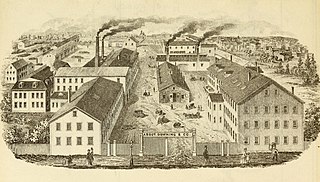
Abbot-Downing Company was a coach and carriage builder in Concord, New Hampshire, which became known throughout the United States for its products — in particular the Concord coach.























